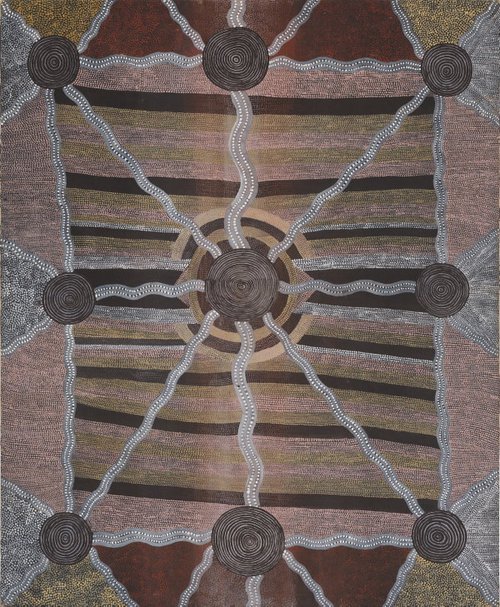Tim Leura Tjapaltjarri
Australia
Born: Napperby, Northern Territory, Australia circa 1929
Died: 1984
Language group: Anmatyerr, Central Desert region
Biography
Tim Leura Tjapaltjarri was born in Napperby Creek and grew up around Napperby Station, around 200 kilometres north west of Mparntwe (Alice Springs), in his traditional Anmatyerr country. After working at Narwietooma Station as a stockman, he moved to Papunya in the late 1950s with his wife Daisy Leura Nakamarra and their young family, when the construction program for the new settlement began.
Tjapaltjarri was already known in Central Australia as a brilliant craftsman in wood before the painting movement began in Papunya in 1971. He presented himself to schoolteacher Geoffrey Bardon and asked to do a painting. The two men became friends, and Tjapaltjarri went on to play a leading role in the emerging Papunya painting enterprise. Bardon recalls Tjapaltjarri encouraging his younger brother, Clifford Possum Tjapaltjarri (their mothers were sisters), to join the ‘painting mob’. They went on to collaborate on some of the land-mark paintings of the era, most notably the 1976 work, Warlugulong. In the mid-1970s, Tim Leura Tjapaltjarri served on the Aboriginal Arts Board of the Australia Council as a Papunya Tula representative.
Bardon’s book, Papunya Tula: Art of the Western Desert contains a detailed map drawn by Tjapaltjarri. It shows his country and the sacred sites of the Rrpwamper (possum), Anek (yam), Rwang (fire), Lhwelk (blue-tongue lizard), Atwern (sun), Atay (moon) and Morning Star and other Tjukurrpa. Tjapaltjarri’s paintings were often sombre in both colour and content, which some observers believe reflected the artist’s profound sadness at the loss of the old ways of living. However, Dick Kimber, who knew Tjapaltjarri over a long period, contends that it was ‘ … more a deep sense of family attachment, and strong recall of his father and grandfather and their association with the country’.
The bold heraldic design of Kooralia, 1980, is in some ways atypical, but its subtle evocation of a moonbeam falling across the striped sands of the Napperby Creek bed exemplifies the artist’s interest in atmospherics, particularly night effects. Despite a painting career cut short by his untimely death, the paintings of Tjapaltjarri remain a telling influence on the work of many Western Desert artists.
Vivien Johnson in 'Tradition today: Indigenous art in Australia’, Art Gallery of New South Wales, Sydney, 2014

